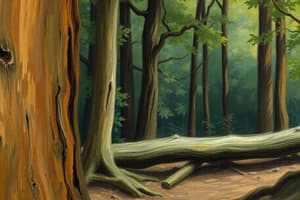Podcast
Questions and Answers
What is the main reason for drying wood in wood products processing?
What is the main reason for drying wood in wood products processing?
- To protect wood from insects and fungal decay
- To eliminate dimensional change through shrinkage (correct)
- To improve the appearance of the wood
- To reduce the transportation cost of wood products
Why does drying time increase with wood thickness?
Why does drying time increase with wood thickness?
- Because thicker wood has a higher moisture content
- Because water moves faster in thicker wood
- Because wood is more prone to drying defects with increasing thickness (correct)
- Because wood density increases with thickness
What is the ideal moisture content for timber intended for general purposes?
What is the ideal moisture content for timber intended for general purposes?
- 8% MC
- 15% MC
- 12% MC (correct)
- 20% MC
What is the estimated loss of timber due to different seasoning practices?
What is the estimated loss of timber due to different seasoning practices?
Why is seasoned timber stronger than green timber?
Why is seasoned timber stronger than green timber?
What happens to water in wood during the drying process?
What happens to water in wood during the drying process?
What is the advantage of seasoned timber in terms of wood finishing?
What is the advantage of seasoned timber in terms of wood finishing?
What happens to the electrical and thermal insulation properties of wood after seasoning?
What happens to the electrical and thermal insulation properties of wood after seasoning?
What is the primary reason why moisture moves to the surface more slowly in heartwood than in sapwood?
What is the primary reason why moisture moves to the surface more slowly in heartwood than in sapwood?
What is the term used to express the amount of water present in wood?
What is the term used to express the amount of water present in wood?
What is the primary purpose of drying wood?
What is the primary purpose of drying wood?
What is the difference between free water and bound water in wood?
What is the difference between free water and bound water in wood?
What is the effect of variation in moisture content on wood?
What is the effect of variation in moisture content on wood?
What is the purpose of measuring the moisture content of wood?
What is the purpose of measuring the moisture content of wood?
How is the moisture content of wood typically measured?
How is the moisture content of wood typically measured?
What is the result of drying wood from the outside in?
What is the result of drying wood from the outside in?
Flashcards are hidden until you start studying
Study Notes
Drying of Wood
- Drying is a time-consuming and energy-intensive process in wood processing that can cause defects like surface and internal checks, collapse, splits, and warp.
- Rapid drying increases the risk of these defects, and drying time increases more than proportionally with wood thickness.
- Different species of wood have varying drying rates and susceptibilities to drying defects.
- Timber for general purposes needs to be seasoned to around 12% moisture content (MC), which depends on the atmospheric conditions of the locality.
Importance of Drying Wood
- Drying eliminates dimensional change through shrinkage and checks movement in finished products.
- It prevents losses through cracking, splitting, and warping.
- Drying protects wood from primary decay, fungal stain, and insect attacks.
- Seasoned timber is lighter, stronger, and takes preservatives better than green timber.
- It also improves wood's electrical and thermal insulation properties and works better with finishes and glues.
How Wood Dries
- Wood should be dried to a final MC around the mid-range of its expected surroundings.
- Water in wood moves from higher to lower zones of moisture content, and wood dries from the outside in.
- Drying involves two phases: movement of water from the interior to the surface and removal of water from the surface.
- Moisture moves more slowly in heartwood than in sapwood due to extractives plugging the pits.
Moisture Content of Wood
- Moisture content is the percentage of water present in wood relative to its oven-dry weight.
- Determining MC involves destructive testing or using an electrical moisture meter.
- MC varies within a tree and between trees, and changes with the surrounding atmosphere.
- Variations in MC affect wood properties like shrinkage, strength, electrical and thermal properties, and susceptibility to fungal infection.
- Wood contains two types of water: free water in cell cavities and bound water in cell walls, which require different amounts of energy to remove.
- Bound water affects wood properties more than free water, but free water affects thermal conductivity and permeability.
Studying That Suits You
Use AI to generate personalized quizzes and flashcards to suit your learning preferences.




